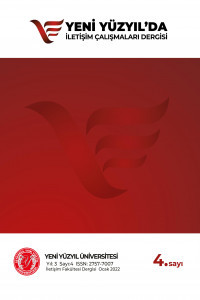Yapay Zekanın Görsel Sanatlara Etkisi: Yapay Zeka İle Üretilen Atatürk Portrelerinin İçerik Analizi
Yapay Zeka, Atatürk Portreleri, Prompt, İnsan- Bilgisayar Etkileşimi
The Impact of Artificial Intelligence on Visual Arts: A Content Analysis of Atatürk Portraits Produced With Artifıcial Intelligence
Artificial Intelligence, Atatürk Portraits, Prompt,
___
- Amirhosseini, M. K. (2019). Automating the Process of Identifying the Preferred Representational System in Neuro Linguistic Programming Using Natural Language Processing. Cognitive Processing(20), 175-193.
- Atan, A., Uçan, B., & Bilsel, Ç. (2015). Dijital Sanat Uygulamaları Üzerine Bir İnceleme. İstanbul Aydın Üniversitesi Dergisi(26), s. 1-14.
- Aydın, T. (2022). Atatürk Döneminde Bürokrasi ve Modernleşme. Konya: Palet Yayınları.
- Bala, A., Padmaja, T., & Gopisettry, D. (2018). Auto-Dialog Systems: Implementing Automatic Conversational Man-Machine Agents by Using Artificial Intelligence & Neural Networks. International Journal of Scientific Research and Review, 7(1), 1-5.
- Bush, V. (1945, Temmuz). As We May Think. The Atlantic Monthly(196), 101-108.
- Campbell-Kelly, M., Aspray, W., Ensmenger, N., & Yost, J. (2013). Computer: A History of the Information Machine. A.B.D.: Westview Press.
- Cohen, P. (2016). Harold Cohen and AARON. AI Magazine, 37(4), s. 63-66.
- Ekiz, H., Vatansever, F., Zengin, A., & Demir, Z. (2000). Hesaplamanın Tarihi ve Bilgisayarların Gelişimi. Sakarya Üniversitesi Fen Bilimleri Enstitüsü Dergisi, 4(1-2), s. 73-81.
- Garfinkel, S. L., & Grunspan, R. H. (2018). The Computer Book: From the Abacus to Artificial Intelligence, 250 Milestones in the History of Computer Science. A.B.D.: Union Square & Co.
- Goldstine, H. H. (1980). The Computer from Pascal to von Neumann. A.B.D.: Princeton University Press.
- Goodfellow, I., Bengio, Y., Courville, A., & Bach, F. (2017). Deep Learning (Adaptive Computation and Machine Learning Series). A.B.D.: MIT Press.
- Hastie, T., Tibshirani, R., & Friedman, J. (2016). The Elements of Statistical Learning: Data Mining, Inference, and Prediction. A.B.D.: Springer.
- Hurwitz, J., & Kirsch, D. (2018). Machine Learning, IBM Limited Edition. New Jersey: John Wiley & Sons, Inc.
- Krithikaa, M. (2016). International Journal of Trend in Research and Development. 3(1), 74-77.
- Landow, G. P. (1991). Hypertext: The Convergence of Contemporary Critical Theory and Technology. A.B.D.: The Johns Hopkins University Press.
- Myers, B. A. (1998). A Brief History of Human Computer Interaction Technology. Interactions, s. 44-54.
- Nelson, T. H. (1974). Computer Lib: You Can and Must Understand Computers Now. A.B.D.: South Bend.
- Nyce, J. M., & Kahn, P. (1992). From Memex to Hypertext: Vannevar Bush and the Mind's Machine. A.B.D.: Academic Press.
- Özçift, A., Çelikten, A., & Akarsu, K. (2020). Yapay Zeka Kavramlarına Giriş. Ankara: Gece Kitaplığı.
- Russell, S. J., & Norvig, P. (2010). Artificial Intelligence A Modern Approach. New Jersey: Pearson Education Inc.
- Taluğ, D. Y., & Eken, B. (2023). Görsel Tasarımda İnsan Yaratıcılığı ve Yapay Zekanın Kesişimi. Journal of Art and Iconography,, 1(4), s. 18-29.
- Toprak, A. (2020). Yapay Zekâ Algoritmalarının Dijital Enstalasyona Dönüşmesi. Ege Üniversitesi İletişim Fakültesi Yeni Düşünceler Hakemli E-Dergisi(14), s. 47-59.
- İnternet Kaynakları
- Berners-Lee, T., Hendler, J., & Lassila, O. (2001, 05 17). The Semantic Web: A New Form of Web Content That is Meaningful to Computers Will Unleash a Revolution of New Possibilities. https://www.researchgate.net/publication/225070375_The_Semantic_Web_A_New_Form_of_Web_Content_That_is_Meaningful_to_Computers_Will_Unleash_a_Revolution_of_New_Possibilities [Erişim Tarihi: 21.07.2023].
- Bimaplus. (2018). The Very Beginning of the Digital Representation – Ivan Sutherland Sketchpad. https://bimaplus.org/news/the-very-beginning-of-the-digital-representation-ivan-sutherland-sketchpad/ [Erişim Tarihi: 03.09.2023].
- Akten, M. (2020). The Unreasonable Ecological Cost of #CryptoArt (Part 1). Medium: https://memoakten.medium.com/the-unreasonable-ecological-cost-of-cryptoart-2221d3eb2053 [Erişim Tarihi: 12.10.2023].
- Alicerosebell. (2013). Vannevar Bush, Science, the World’s Brain and Inventing the Web. https://alicerosebell.wordpress.com/2013/07/30/vannevar-bush-science-the-worlds-brain-and-inventing-the-web/ [Erişim Tarihi: 13.09.2023].
- Çelik, F. (2021). Dünden Bugüne Dijital Sanat. oggusto: https://www.oggusto.com/sanat/dijital-sanat-nedir [Erişim Tarihi: 12.08.2023].
- Ertan, E. (2014). Dijital Sonrası Tarihçeler: Türkiye’de Yeni Medya Sanatı. https://forumist.com/dijital-sonrasi-tarihceler-turkiyede-yeni-medya-sanati/ [Erişim Tarihi: 02.09.2023].
- Gajitz. (2009). On the Origin of Mouse: First Mouse (Nearly) Lost to History. https://gajitz.com/on-the-origin-of-mouse-first-mouse-nearly-lost-to-history/ [Erişim Tarihi: 20.08.2023].
- Statler, T. (2023). History Of Computers With Timeline. https://compscicentral.com/history-of-computers/#:~:text=Timeline%20Of%20Computer%20History%201%20The%20First%20Digital,...%208%20The%20Turing%20Machine%20...%20Di%C4%9Fer%20%C3%B6%C4%9Feler [Erişim Tarihi: 03.09.2023].
- Merriam-Webster. (2023). Computer. https://www.merriam-webster.com/dictionary/computer#:~:text=Definition%20of%20computer.%20%3A%20one%20that%20computes%20specifically,to%20design%203-D%20models.%20Keep%20scrolling%20for%20more [Erişim Tarihi: 08.09.2023].
- Ximnet. (2022, May 04). What’s The Future Of Human-Computer Interaction (HCI)? July 20, 2023 tarihinde https://ximnet.medium.com/whats-the-future-of-human-computer-interaction-hci-71c9a81abd54 [Erişim Tarihi: 08.09.2023].
- Başlangıç: 2020
- Yayıncı: İstanbul Yeni Yüzyıl Üniversitesi
DİLİN YENİLEŞME SÜRECİNDE RADYO VE TELEVİZYON SPİKERLERİ: 1927-1990
REKABETÇİ KİMLİK TEORİSİ ÇERÇEVESİNDE KARADENİZ VAPURU (1926) PROJESİ ÜZERİNE KISA BİR ANALİZ
Cumhuriyet Devrimleri’nin Halkla İlişkileri ve Asimetrik Model Uygulaması
Serra İnci ÇELEBİ, Çağdaş Lara ÇELEBİ
TÜRK HARF DEVRİMİ VE BASINA YANSIMALARI
CUMHURİYETİN 100. YILINDA REKLAM VE TÜKETİCİ ALGISI: REKLAM OKURYAZARLIĞININ BİBLİYOMETRİK ANALİZİ
TELEKSTEN ROBOT GAZETECİLİĞE: TÜRKİYE’NİN BİR ASIRLIK MEDYA SERÜVENİNE ELEŞTİREL BİR YAKLAŞIM
Yapay Zekanın Görsel Sanatlara Etkisi: Yapay Zeka İle Üretilen Atatürk Portrelerinin İçerik Analizi
CUMHURİYET DÖNEMİ ULUS KİMLİK İNŞASINDA MÜZE, KÜLTÜR VE SANAT YÖNETİMİ
DEĞİŞEN TÜRK KADININI CUMHURİYET DİZİSİ BAĞLAMINDA YORUMLAMAK
